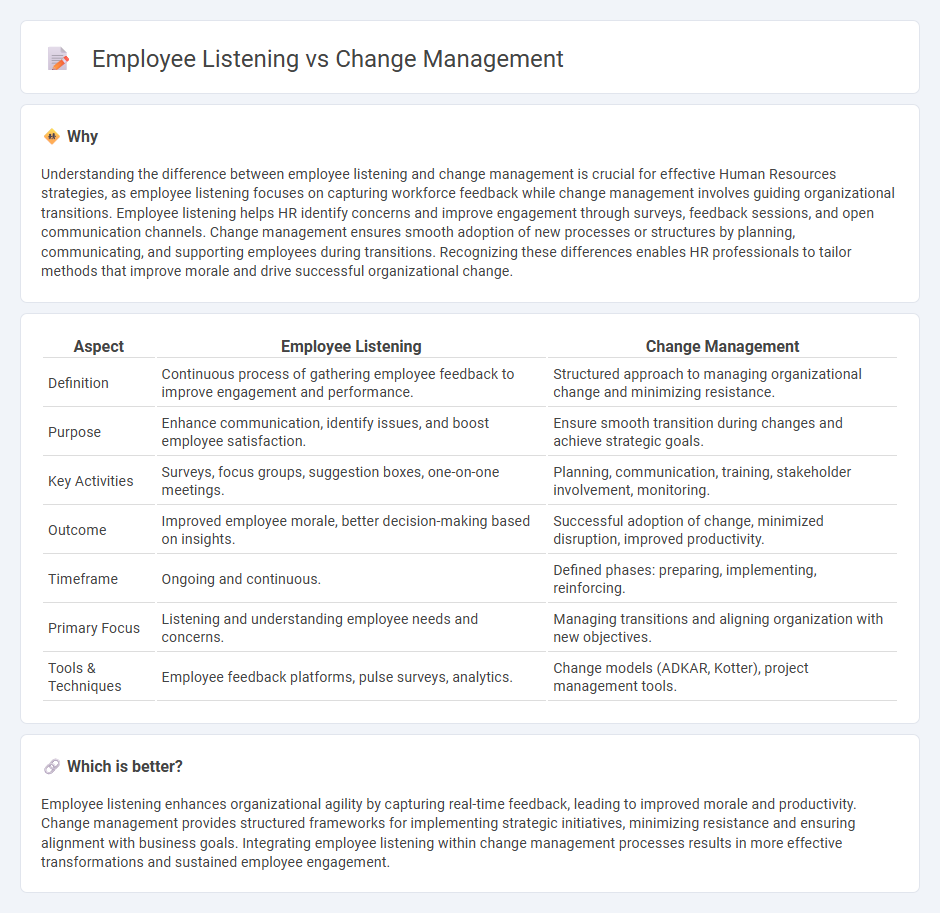
Employee listening gathers real-time feedback to understand workforce needs and sentiments, driving informed decisions. Change management uses these insights to effectively implement transitions, ensuring employee engagement and minimizing resistance. Explore how integrating employee listening enhances change management success.
Why it is important
Understanding the difference between employee listening and change management is crucial for effective Human Resources strategies, as employee listening focuses on capturing workforce feedback while change management involves guiding organizational transitions. Employee listening helps HR identify concerns and improve engagement through surveys, feedback sessions, and open communication channels. Change management ensures smooth adoption of new processes or structures by planning, communicating, and supporting employees during transitions. Recognizing these differences enables HR professionals to tailor methods that improve morale and drive successful organizational change.
Comparison Table
| Aspect | Employee Listening | Change Management |
|---|---|---|
| Definition | Continuous process of gathering employee feedback to improve engagement and performance. | Structured approach to managing organizational change and minimizing resistance. |
| Purpose | Enhance communication, identify issues, and boost employee satisfaction. | Ensure smooth transition during changes and achieve strategic goals. |
| Key Activities | Surveys, focus groups, suggestion boxes, one-on-one meetings. | Planning, communication, training, stakeholder involvement, monitoring. |
| Outcome | Improved employee morale, better decision-making based on insights. | Successful adoption of change, minimized disruption, improved productivity. |
| Timeframe | Ongoing and continuous. | Defined phases: preparing, implementing, reinforcing. |
| Primary Focus | Listening and understanding employee needs and concerns. | Managing transitions and aligning organization with new objectives. |
| Tools & Techniques | Employee feedback platforms, pulse surveys, analytics. | Change models (ADKAR, Kotter), project management tools. |
Which is better?
Employee listening enhances organizational agility by capturing real-time feedback, leading to improved morale and productivity. Change management provides structured frameworks for implementing strategic initiatives, minimizing resistance and ensuring alignment with business goals. Integrating employee listening within change management processes results in more effective transformations and sustained employee engagement.
Connection
Employee listening provides critical insights into workforce sentiments and challenges, enabling HR to design more effective change management strategies. By actively gathering and analyzing employee feedback, organizations can identify resistance points and tailor communication to foster engagement and trust. This integration increases the likelihood of successful adoption and sustainability of organizational changes.
Key Terms
**Change Management:**
Effective change management involves structured processes to guide organizations through transitions, emphasizing clear communication, stakeholder engagement, and training. Success depends on addressing employee resistance and aligning change initiatives with organizational goals to ensure smooth adoption and sustained improvements. Explore more strategies and best practices in change management to drive impactful transformation.
Communication
Change management emphasizes structured communication strategies to guide employees through organizational transitions, ensuring clarity and alignment with new goals. Employee listening focuses on gathering feedback and fostering open dialogues to understand concerns and improve engagement throughout change processes. Explore how aligning communication in both approaches enhances successful transformation outcomes.
Stakeholder Engagement
Change management emphasizes structured strategies to guide organizational transitions, ensuring stakeholder engagement through clear communication and participation frameworks. Employee listening prioritizes capturing authentic feedback from employees to foster trust and align initiatives with workforce needs, directly enhancing stakeholder buy-in. Explore best practices to integrate change management with effective employee listening for optimal stakeholder engagement outcomes.
Source and External Links
What is Change Management? Definition & Process - WalkMe - Change management is a coordinated approach to handling the human aspects of organizational change through clear vision, objectives, training, support, resistance management, and continuous monitoring to ensure sustainable change within an organization.
What is Change Management? - IBM - Change management is the structured method organizations use to communicate and implement change, focusing on supporting people and processes to adapt successfully, especially amidst technological or leadership shifts, and embedding change into company culture.
What is Change Management? Organizational, Process ... - ASQ - Change management involves defining and assessing change risks, planning carefully with employee engagement, and clearly communicating to mitigate impact on business performance and ensure smooth adoption of new processes or strategies.
 dowidth.com
dowidth.com